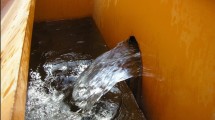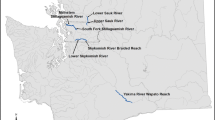Abstract
Dewatering of the groundwater resource and associated reduced flow of surface water features are potential negative impacts when constructing underground facilities. Little work has been done to develop methods for the early detection of environmental impacts on water resources where major underground construction is being undertaken. Recognizing this, prior to construction of two rock tunnels in the southwestern USA, a 3-year preconstruction program was implemented to monitor over 100 wells, springs, and streams in the project area that might be affected. This preconstruction monitoring phase has established data for a hydrologic reference which indicates a high degree of spatial and temporal variability. This variability must be accounted for when trying to identify construction-related impacts. The project area was subdivided into areas of similar characteristics based on geologic and hydrologic features. Measurements from features within each unit were then normalized and aggregated to derive a single representative flow parameter. This representative flow was then correlated to precipitation and major stream flow records to allow for a method of estimating unimpacted flow and groundwater levels during and after construction. Application of this method proved useful in determining and enabling a quick response to construction-related impacts.
Résumén
El drenaje de recursos de agua subterránea con la reducción asociada de flujo de agua superficial constituyen impactos potenciales negativos cuando se construyen instalaciones subterráneas. Se ha hecho poco trabajo para desarrollar métodos que permitan la detección temprana de impactos ambientales en los recursos hídricos donde se están desarrollando construcciones subterráneas grandes. Tomando esto en cuenta se implementó, con anticipación de tres años antes del inicio de la obra, un programa de monitoreo abarcando más de 100 pozos, manantiales, y arroyos, en el área donde se construirían dos túneles en roca en el suroeste de Estados Unidos. Esta fase de monitoreo en la etapa de pre-construcción estableció datos para un marco hidrológico el cual indica un alto grado de variabilidad temporal y espacial. Debe de explicarse esta variabilidad cuando se trata de identificar los impactos relacionados con la construcción. El área del proyecto se dividió en áreas de características similares en base a las características hidrológicas y geológicas. Se normalizaron las mediciones de ciertas características dentro de cada unidad y se agregaron para derivar un parámetro único de flujo representativo. Este flujo representativo se correlacionó con la lluvia y los registros de caudales de los ríos principales para estimar un método que permita calcular flujos sin impacto y niveles de agua subterránea durante y después de la construcción. La aplicación de este método mostró ser útil en determinar y permitir una respuesta rápida a impactos relacionados con la construcción.
Résumé
L’épuisement des ressources en eau souterraine et le phénomène conséquent de la baisse du régime des eaux de surface sont des impacts potentiels et négatifs lies à la construction souterraine. Peu d’études ont porté sur le développement de méthodes de détection des impacts environnementaux sur les ressources hydrologiques, lorsque de grandes constructions souterraines sont planifiées. Dés lors, avant la construction de deux tunnels dans la roche dans le Sud-Ouest des USA, un programme de pré construction sur trois ans, visant le suivi d’une centaine de puits, sources et cours d’eau, a été mis en place. Cette phase de surveillance précédant la construction, a permis d’établir un état de référence hydrologique révélant entre autre l’importance de la variabilité spatiale et temporelle. Cette variabilité doit être prise en compte lorsque l’on s’essaye à la définition des impacts. La zone d’étude a été subdivisée par entités présentant des caractéristiques géologiques et hydrologiques communs. Les mesures de ces différentes entités ont été ensuite normalisées et agrégées de manière à n’en sortir qu’un seul et unique paramètre d’écoulement. Cet écoulement représentatif a été corrélé aux enregistrements de débits et de précipitation, permettant la mise en place d’une méthode d’estimation de l’impact pendant et après la construction, sur les niveaux piézométriques et les débits. Il est prouvé que cette méthode est fort utile, apportant une réponse rapide à la caractérisation des impacts.








Similar content being viewed by others
References
Anna L, Fahy M, Bianchi R, McKeown M, Chatoian J (2003) Effects of tunneling on the groundwater resources of the southwestern San Bernardino Mountains, California, CA. Proceedings of the International Conference on Groundwater in Fractured Rocks, International Association of Hydrogeologists, 15–19 September 2003, Prague, Czech Republic
Goodman RE, Moye DG, Van Schalkwyk A, Javandel I (1965) Ground water inflows during tunnel driving. Eng Geol 2(1):39–56
Heuer R (1995) Estimating rock tunnel water inflow. Proceedings of the Rapid Excavation and Tunneling Conference, June 2003, San Francisco, CA
Li H, Kagami H (1997) Groundwater level and chemistry changes resulting from tunnel construction near Matsumoto City, Japan. Environ Geol 31(1–2):76–84
Molinero J, Samper J, Juanes R (2002) Numerical modeling of the transient hydrogeological response produced by tunnel construction in fractured bedrocks. Eng Geol 64(4):369–368
Rantz SE (1962) Flow of springs and small streams in the Tecelote tunnel area of Santa Barbara County, California. US Geological Survey Water Supply Paper 1619-R, USGS, Reston, VA
Author information
Authors and Affiliations
Corresponding author
Rights and permissions
About this article
Cite this article
Attanayake, P.M., Waterman, M.K. Identifying environmental impacts of underground construction. Hydrogeol J 14, 1160–1170 (2006). https://doi.org/10.1007/s10040-006-0037-0
Received:
Accepted:
Published:
Issue Date:
DOI: https://doi.org/10.1007/s10040-006-0037-0




